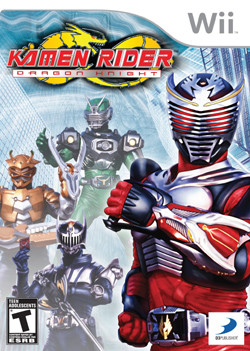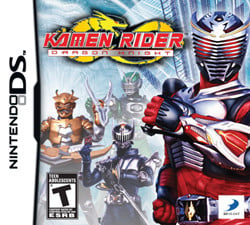The X Button
Dragon Chasing
by Todd Ciolek,

I hope you've all tried the Bayonetta demo by this point. It's out on Xbox Live and the PlayStation Network, and it gives a flattering portrait of Hideki Kamiya's action-game follow-up to Devil May Cry. Specifically, it's a portrait of a lithe, heavily armed witch who can breakdance while firing pistols mounted on her shoes. It's an insane demo full of ridiculously novel battles, and it's scored Bayonetta points with lot of people.

Well, I'm not one of those people. You want to know why not? Because Bayonetta herself is a rip-off of Millia Rage from Guilty Gear, that's why not.

See, part of Bayonetta's gimmick is that her clothes are formed out of her own hair, and that hair sometimes leaves her body to create various weapons, including a giant, boss-devouring dragon. Millia does pretty much the same thing, shaping her tresses into blades, crescent moons, seats, and mocking gestures. The only real difference is that Millia doesn't actually wear her hair or get nearly naked in battle, though I imagine someone at Guilty Gear's publisher now wishes they'd thought of that first.
You all know what to do. Write your representatives in congress! Start online petitions! Make angry posts on completely unrelated forums! Oh, and play Bayonetta anyway, because no one should care too much about the main character's minor aesthetic points. Not when she's blasting monstrous angels with foot-guns, anyway.
NEWS
FINAL FANTASY XIII SHOWS ITS CID
In the rampant news about Final Fantasy XIII, I hadn't noticed the absence of the game's Cid. Every Final Fantasy has a Cid, and Final Fantasy XII's insane scientist ham of a Cid is an unfairly hard act to follow. But Final Fantasy XIII is going against tradition. Cid's usually an older, wiser figure in the games, but the latest Final Fantasy has a dashing Cid apparently in the flower of his mid-thirties.

Cid Reins, as he is known, is a commander in the employ of the Sanctum, the theocratic regime that controls the city of Cocoon and hunts down the game's heroes. This puts him in direct opposition to heroine Lightning and the rest of the l'Cie cast, though it also gives him an airship all his own. Perhaps this Cid will change his mind and join the heroes in some capacity, though don't expect him to be a playable party member.
SUNSOFT RETURNS TO SOMEWHERE JUST OUTSIDE THE SPOTLIGHT
 Sunsoft is one of those developers that almost, almost made it big back in the NES era. They had Batman, they had Blaster Master, and they had some of the best music that ever came out of Nintendo's boxy little console. Unfortunately, Sunsoft just couldn't keep up the show or make the leap to the big time like Capcom and Konami did. The mid-1990s saw the company fading from prominence and even fighting back bankruptcy for a little while. Sunsoft bowed out in America with Blaster Master: Blasting Again and some other budget releases back around 2001. Now they're coming back, with the help of former Working Designs president Victor Ireland.
Sunsoft is one of those developers that almost, almost made it big back in the NES era. They had Batman, they had Blaster Master, and they had some of the best music that ever came out of Nintendo's boxy little console. Unfortunately, Sunsoft just couldn't keep up the show or make the leap to the big time like Capcom and Konami did. The mid-1990s saw the company fading from prominence and even fighting back bankruptcy for a little while. Sunsoft bowed out in America with Blaster Master: Blasting Again and some other budget releases back around 2001. Now they're coming back, with the help of former Working Designs president Victor Ireland.
Ireland's Gaijinworks label is now helping Sunsoft in bringing games to the Wii's Virtual Console, starting with Blaster Master this month. According to Ireland, this is the start of an ambitious project regarding Sunsoft's history, and that could mean Virtual Console releases for the underrated NES games Ufouria and Mr. Gimmick. Or perhaps it's something from Sunsoft's Albert Odyssey series, which visited the American Saturn courtesy of Working Designs back in 1997. We'll find out more in a few weeks. I'd say that's really several years in Working Designs time, but that joke hasn't been funny or relevant since 2001.
SOME GAME CALLED YAKUZA 3 COMING TO THE U.S.
Good news! We can all finally shut up about whether or not Sega will release Yakuza 3 in North America. March 2010. For the PlayStation 3. With Japanese voices and English subtitles. Go nuts.

While the first two proper Yakuzas had heroic mobster Kiryu stomping around crime-plagued cities, the third puts him and his adopted daughter Haruka in charge of an orphanage. The two of them fend off greedy land developers who want to turn the orphanage into a tourist pit, and while that sounds like the stuff of cliched, mustache-twirling villainy, there's a larger plot involving politicians, government agents, and, of course, the criminal underworld. It also offers the usual Yakuza diversions, such as dating club hostesses and thrashing street toughs. An unfortunate rumor has it that Sega might remove the hostess-dating from the game for its English release, which I imagine would rile the Yakuza fans to a horrible extreme.
Yakuza 3 is technically the fourth game in Sega's little series, as a spin-off called Ryu ga Gotoku Kenzan! brought the Yakuza vein of gameplay to medieval Japan back in 2008. And now we can all start bothering Sega about that one.
SNK BRINGS MORE POTENTIALLY GOOD PORTS TO XBOX LIVE
SNK recently promised more games for Xbox Live Arcade in Japan, and, to everyone's surprise, they're not just old Neo Geo fighters and remixes thereof. The King of Fighters: Sky Stage, a recent arcade shooter starring several King of Fighters characters, will be available for download on Live next year. Also coming are Neo Geo Battle Coliseum, Metal Slug XX (a tweaked version of Metal Slug 7), and The King of Fighters 2002: Unlimited Match. They're only confirmed for Japan at this writing, but SNK's been good about releasing these things in North America and Europe as well. Will the games have lagging online play like Garou: Mark of the Wolves or untranslated text like The King of Fighters 1998 Ultimate Match? I hope not.
REVIEW: KAMEN RIDER: DRAGON KNIGHT
 Developer: Natsume, Eighting
Developer: Natsume, Eighting
Publisher: D3
Platform: DS, Wii
Players: 1-2
MSRP: $29.99
I'll begin with a potentially embarrassing disclosure: I'm not what you would call a dedicated viewer of Kamen Rider: Dragon Knight. However, I can guarantee that I would be one if I were nine years old. The show is based on Shotaro Ishinomori's superhero story, which has inspired more ridiculous live-action TV series and rubbery tokusatsu monsters than I could ever chronicle here. But Dragon Knight is important among them. Not only is it the first Kamen Rider to break into mainstream American kids' entertainment in years, but it also sports 13 different Kamen Riders, and any child raised in the Power Rangers generation can latch onto a few of those characters. And then they can ask for the Kamen Rider: Dragon Knight games for the Wii and/or DS this holiday season.
In its Wii incarnation, Kamen Rider: Dragon Knight is foremost a fighting game, one with flashy polygon visuals slapped onto rudimentary two-dimensional gameplay. Each character gets two basic attacks and a one-button special move linked to a deck of cards. Unleashing a special attack kills two links on a Kamen Rider's power meter, and shaking the Wii remote throws out an ostentatious special attack with a dramatic buildup to match. It all reveals the game as a showcase for the characters, which include all sorts of variants on the tokusatsu superhero ideal: Dragon Knight gets a whirling, serpentine mecha-dragon, Incisor summons an amusingly hideous crustacean to help him in battle, and Siren gets a robotic swan (that'd be a Gatchaman reference, if I'm not mistaken). My personal favorite ended up being Torque, because he looks like a Virtual On robot and uses powerful firearms in battle. I don't care if that's cheating.

The Wii's Kamen Rider: Dragon Knight is the creation of Eighting, perhaps the gaming industry's most prolific maker of fighters. Eighting's crafted everything from the now-dormant Bloody Roar series to some recent Naruto and Bleach fighters to Tatsunoko vs. Capcom and the ill-received Castlevania: Judgment. In depth, Kamen Rider: Dragon Knight is strictly anime-license fighting. While cancels and a few other semi-complicated ideas pop up, matches are mostly a matter of stringing together attacks and using card-based bonus moves whenever there's an opening. Each character can buy four or five specialized cards and switch through them in battle, making for a little variety in the game's simple combat. Unfortunately, every card-based attack starts up a special scene that runs a few seconds; they're short, but rather annoying once you've seen them a few times.
Beyond the one-on-one fights, Kamen Rider: Dragon Knight offers a basic story mode wherein characters traverse a small map with diverging paths, racking up points to spend on cards. Most of the locations yield the same challenge: wipe out a street full of rock-stupid robot soldiers within a time limit. It's a straightforward, repetitive diversion, brought down further by a simple camera and characters that don't turn around fast enough. The young viewers who idolize a particular Kamen Rider will also be disappointed by the story's brief, text-only endings.

The extra modes would never stand on their own, and together with the rest of Kamen Rider: Dragon Knight, they're only a brief distraction. At least the game looks fair, with decent characters and drab backgrounds. The soundtrack backs everything well enough, and the voice cast will also provide another round of actor-spotting. Hint: Johnny Yong Bosch plays two roles.
 For its DS incarnation, Kamen Rider: Dragon Knight was handed off to Natsume, a developer with less experience in fighters. It's roughly the same game: card-equipped Kamen Riders fight in brawler stages and one-on-one matches against the computer. Yet it's all far more boring here. Only two characters are available from the get-go, and others are slowly unlocked after many stages of fighting the same dense foes over and over. Here Natsume confuses longevity with pure tedium, as each character must plow through 50 or so mission separately.
For its DS incarnation, Kamen Rider: Dragon Knight was handed off to Natsume, a developer with less experience in fighters. It's roughly the same game: card-equipped Kamen Riders fight in brawler stages and one-on-one matches against the computer. Yet it's all far more boring here. Only two characters are available from the get-go, and others are slowly unlocked after many stages of fighting the same dense foes over and over. Here Natsume confuses longevity with pure tedium, as each character must plow through 50 or so mission separately.
The DS version of Kamen Rider: Dragon Knight isn't without its moments, but they're repeated far too much. Each card-based attack launches a power-up scene, and it happens even more often here than in the Wii game. Battles against multiple foes also prove more awkward, especially when you're trying to change targets. The game looks moderately impressive for a 3-D DS fighter, but that matters little when you're forced to take on a shrieking, rotor-backed red ninja five times in a row. Perhaps the greatest disappointment lies in the versus mode, which doesn't seem to have an option for taking on another player over Wi-Fi. That's a criminal offense for any fighting game.
Neither Kamen Rider: Dragon Knight quite escapes the fans-only angle of many licensed games, but there's no question that the Wii version stands prouder. It's a solid time-killer for younger fans of the show, fans who'll likely be disappointed by the drab, repetitious nature of the DS game. Remember that if you're Christmas shopping for a young Kamen Rider: Dragon Knight fan. Or if you're being selfish and buying games for yourself.
RELEASES FOR THE WEEK OF 12-13
KONAMI CLASSICS VOL. 1 AND 2 Developer: Konami
Developer: KonamiPublisher: Konami Platform: Xbox 360 Players: 1-Various MSRP: $19.99 each
These Konami Classics collections are puzzling. Most anthologies of older games group titles that share a common era, franchise, or genre. Konami's new bundles, on the other hand, were apparently formed by haphazardly selecting a mere half-dozen of the company's most recognizable games from the past 30 years. Frogger was one of the first Konami hits and Castlevania: Symphony of the Night is still the best of its series, but they look strange squatting down with the arcade Super Contra. Volume 2 is even more curious and, sadly, more deficient in quality, since it packs in the repetitive side-scroller Rush 'N Attack, the just-kinda-there Track and Field, and the arcade Contra. It raises all sorts of questions: why charge $20 for only three games? And why include the mediocre arcade Contra games when the NES ones are better and more fondly remembered? Why not throw in more obscure Konami games like Penguin Adventure (Hideo Kojima's first title!), Xexex, or Monster Maulers? Hell, we'd even take a port of Martial Champion, a mediocre 1993 fighting game that no one remembers.
|
discuss this in the forum (25 posts) |
this article has been modified since it was originally posted; see change history